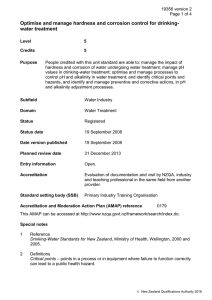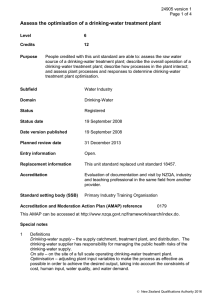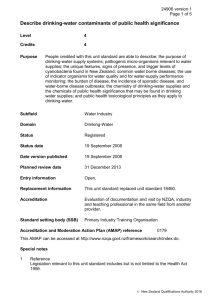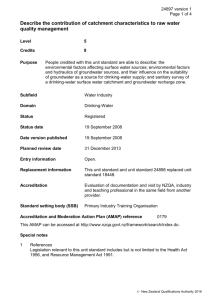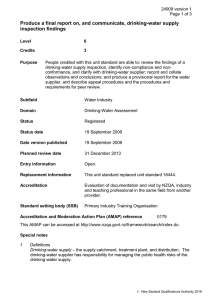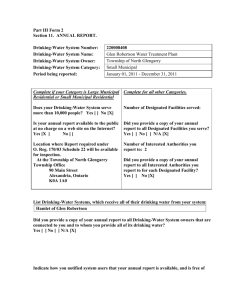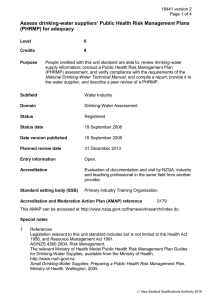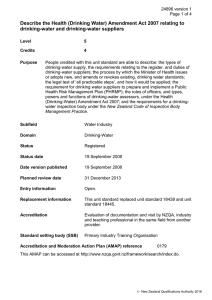18451 Describe the management of pH, alkalinity, hardness
advertisement
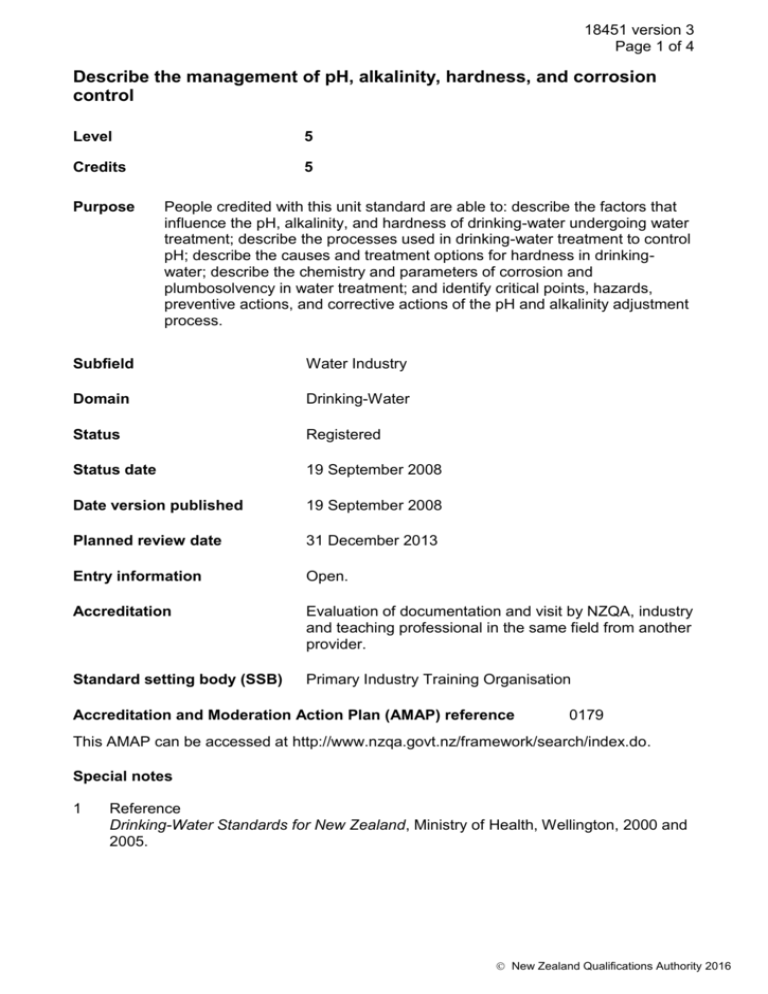
18451 version 3 Page 1 of 4 Describe the management of pH, alkalinity, hardness, and corrosion control Level 5 Credits 5 Purpose People credited with this unit standard are able to: describe the factors that influence the pH, alkalinity, and hardness of drinking-water undergoing water treatment; describe the processes used in drinking-water treatment to control pH; describe the causes and treatment options for hardness in drinkingwater; describe the chemistry and parameters of corrosion and plumbosolvency in water treatment; and identify critical points, hazards, preventive actions, and corrective actions of the pH and alkalinity adjustment process. Subfield Water Industry Domain Drinking-Water Status Registered Status date 19 September 2008 Date version published 19 September 2008 Planned review date 31 December 2013 Entry information Open. Accreditation Evaluation of documentation and visit by NZQA, industry and teaching professional in the same field from another provider. Standard setting body (SSB) Primary Industry Training Organisation Accreditation and Moderation Action Plan (AMAP) reference 0179 This AMAP can be accessed at http://www.nzqa.govt.nz/framework/search/index.do. Special notes 1 Reference Drinking-Water Standards for New Zealand, Ministry of Health, Wellington, 2000 and 2005. New Zealand Qualifications Authority 2016 18451 version 3 Page 2 of 4 2 Definitions Drinking-water supply – the supply catchment, treatment plant, and distribution. The drinking-water supplier has responsibility for managing the public health risks of the drinking-water supply. Critical points – points in a process or in equipment where failure to function correctly can lead to a public health hazard. Organisational procedures – instructions to staff, and procedures which are documented in memo or manual format and are available in the workplace. These requirements include but are not limited to – site specific requirements, manufacturers’ specifications, product quality specifications, and legislative or regulatory requirements. Elements and performance criteria Element 1 Describe the factors that influence the pH, alkalinity, and hardness of drinking-water undergoing water treatment. Performance criteria 1.1 pH, alkalinity, and hardness are described in relation to the expected ranges in the Drinking-Water Standards. 1.2 Organics and inorganics present in untreated water are described in terms of their impact on water pH and alkalinity. Range 1.3 includes but is not limited to – carbon dioxide, carbonate, bicarbonate, sulphates, chlorides, organic colour. Water treatment chemicals are described in terms of their effect on pH and alkalinity. Range includes but is not limited to – alum, hydrated lime, soda ash, caustic soda, carbon dioxide, sulphuric acid. Element 2 Describe the processes used in drinking-water treatment to control pH. Performance criteria 2.1 Chemical addition and removal techniques are described in relation to pH control in water treatment. Range operational issues – solution strengths, material handling safety, chemical transfer, line and pump blockage, chemical safety handling, carry water, powder feeder control, line cleaning; management techniques – material handling safety, equipment selection, equipment maintenance; pH control methods – measurement, calibration, time lags, feedback control loops. New Zealand Qualifications Authority 2016 18451 version 3 Page 3 of 4 2.2 Equipment used to adjust pH is described in terms of their operational features. Range 2.3 equipment – dry powder feeders, mixing tanks, dosing pumps. Problems and operational difficulties are described in relation to the adjustment of pH in drinking-water. Range chemical transfer, line and pump blockage, chemical safety handling, carry water, powder feeder control, line cleaning. Element 3 Describe the causes and treatment options for hardness in drinking-water. Performance criteria 3.1 Naturally occurring chemicals present in raw water are described in terms of their solubility and effect on the temporary and permanent hardness of the water. Range includes but is not limited to – calcium carbonate, magnesium carbonate. 3.2 The lime, soda ash, and caustic soda softening processes used in water treatment are described in terms of their chemistry and methods of operation. 3.3 Ion exchange softening processes used in water treatment are described in terms of their chemistry and methods of operation. Range includes but is not limited to – zeolites, greensands, synthetic resins, brine regeneration. Element 4 Describe the chemistry and parameters of corrosion and plumbosolvency in water treatment. Performance criteria 4.1 The chemistry of metal corrosion and plumbosolvency is identified and described in terms of corrosion cell actions, and the drinking-water standards maximum accepted values (MAVs). Range 4.2 anodic/cathodic areas, pitting, tuberculation, iron, copper, aluminium, cadmium, zinc, lead. Metal corrosion parameters are identified and calculated in terms of the Langelier Saturation Index (LSI), and guideline values in the drinking-water standards. New Zealand Qualifications Authority 2016 18451 version 3 Page 4 of 4 4.3 Asbestos cement corrosion is described in terms of the impact of pH and alkalinity. Element 5 Identify critical points, hazards, preventive actions, and corrective actions of the pH and alkalinity adjustment process. Performance criteria 5.1 The critical points in the pH and alkalinity adjustment process are identified in accordance with organisational procedures. 5.2 The hazards at each critical point are identified in terms of the causes of the events leading to their appearance, and the risk factors. 5.3 The preventive and corrective actions for events related to each hazard are identified. Please note Providers must be accredited by NZQA, or an inter-institutional body with delegated authority for quality assurance, before they can report credits from assessment against unit standards or deliver courses of study leading to that assessment. Industry Training Organisations must be accredited by NZQA before they can register credits from assessment against unit standards. Accredited providers and Industry Training Organisations assessing against unit standards must engage with the moderation system that applies to those standards. Accreditation requirements and an outline of the moderation system that applies to this standard are outlined in the Accreditation and Moderation Action Plan (AMAP). The AMAP also includes useful information about special requirements for organisations wishing to develop education and training programmes, such as minimum qualifications for tutors and assessors, and special resource requirements. Comments on this unit standard Please contact the Primary Industry Training Organisation standards@primaryito.ac.nz if you wish to suggest changes to the content of this unit standard. New Zealand Qualifications Authority 2016
